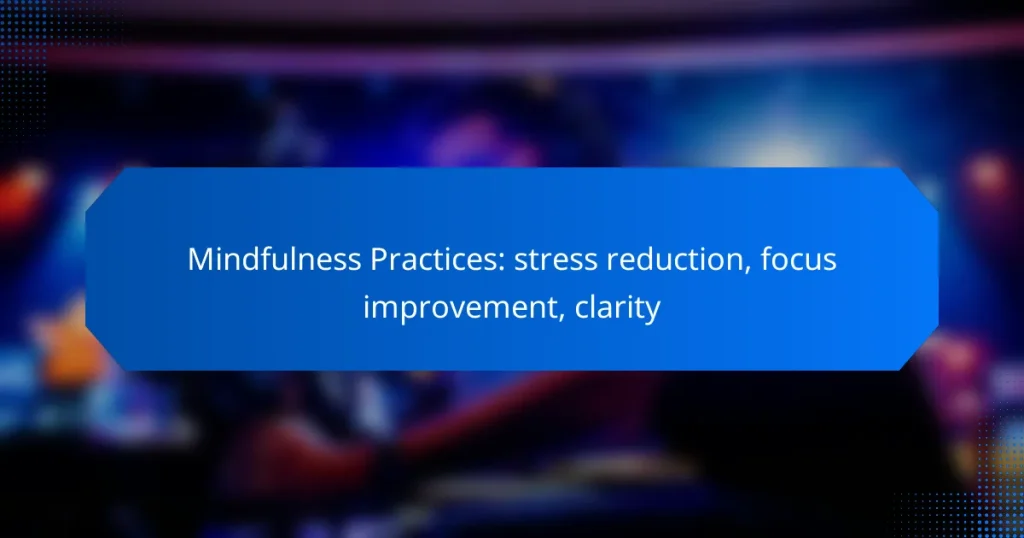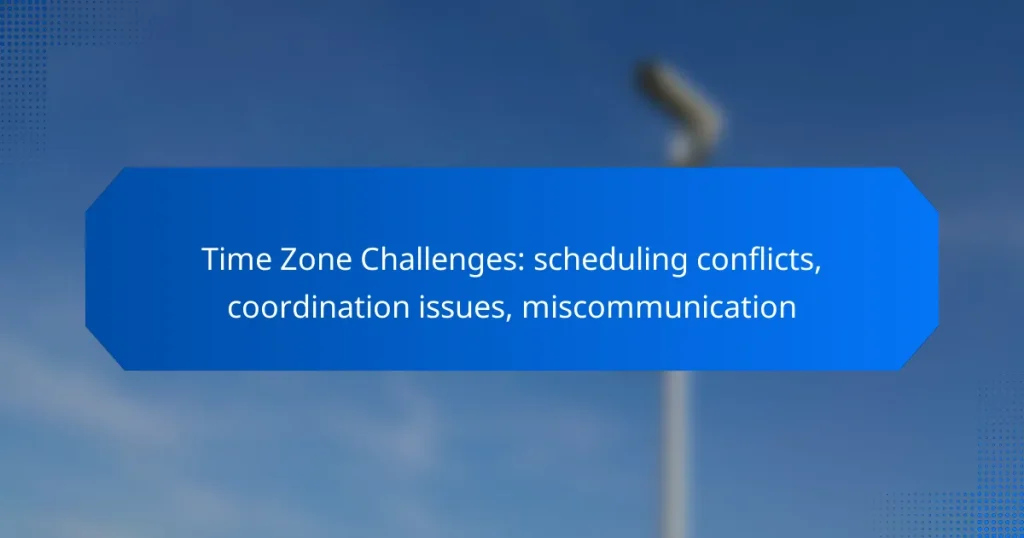Effective time management is crucial for enhancing productivity and achieving personal and professional goals. By prioritizing tasks and utilizing technology, individuals can allocate their time more efficiently and reduce stress. Addressing common challenges such as procrastination and distractions is essential for mastering time management and maintaining focus on what truly matters.
Time Zone Challenges: scheduling conflicts, coordination issues, miscommunication
Accountability Partners: support systems, motivation, goal achievement
What are effective time management strategies?
Effective time management strategies help individuals prioritize tasks, allocate time efficiently, and achieve their goals. By implementing these strategies, one can enhance productivity and reduce stress associated with time constraints.
Prioritization techniques
Prioritization techniques involve identifying tasks based on their urgency and importance. The Eisenhower Matrix is a popular method, categorizing tasks into four quadrants: urgent and important, important but not urgent, urgent but not important, and neither urgent nor important. This helps focus on what truly matters.
Another approach is the ABCDE method, where tasks are ranked from A (most important) to E (least important). This simple system allows for quick decision-making on what to tackle first, ensuring that critical tasks receive attention.
Time blocking methods
Time blocking involves scheduling specific blocks of time for different tasks or activities throughout the day. By allocating dedicated time slots, individuals can minimize distractions and maintain focus on one task at a time. For instance, setting aside two hours in the morning for deep work can enhance productivity.
To implement time blocking effectively, consider using a digital calendar or planner. Color-coding different types of tasks can also help visualize your day and ensure a balanced approach to work and breaks.
Pomodoro Technique
The Pomodoro Technique is a time management method that breaks work into intervals, traditionally 25 minutes long, followed by a short break. This technique promotes sustained focus and helps prevent burnout. After four intervals, a longer break of 15-30 minutes is recommended.
To use this technique, set a timer for 25 minutes and concentrate on a single task. When the timer goes off, take a short break to recharge. This method can be particularly effective for tasks that require intense concentration, such as studying or coding.
Goal setting frameworks
Goal setting frameworks provide structured approaches to define and achieve objectives. The SMART criteria—Specific, Measurable, Achievable, Relevant, and Time-bound—are widely used to create clear and actionable goals. This framework ensures that goals are realistic and trackable.
Another popular method is OKRs (Objectives and Key Results), which help align individual goals with broader organizational objectives. Setting quarterly OKRs can enhance motivation and provide a clear focus on what needs to be accomplished.
Delegation practices
Delegation practices involve assigning tasks to others to optimize time management and focus on high-priority activities. Effective delegation requires understanding team members’ strengths and weaknesses, ensuring the right tasks are assigned to the right people.
To delegate successfully, communicate clearly about expectations and deadlines. Regular check-ins can help monitor progress and provide support, fostering a collaborative environment where everyone contributes to the overall goals.
How can technology enhance time management?
Technology can significantly enhance time management by providing tools that streamline tasks, improve organization, and increase productivity. By leveraging various applications and software, individuals can better allocate their time and focus on what matters most.
Time management apps
Time management apps help users track their activities, set goals, and prioritize tasks effectively. Popular options include Todoist, Trello, and Asana, which allow users to create to-do lists, assign deadlines, and monitor progress. These apps often feature reminders and notifications to keep users accountable.
When selecting a time management app, consider factors such as user interface, integration with other tools, and whether it offers collaboration features. Many apps offer free versions with essential functionalities, while premium versions provide advanced features for a monthly or annual fee.
Task automation tools
Task automation tools streamline repetitive tasks, freeing up time for more critical activities. Tools like Zapier and IFTTT enable users to create workflows that connect different applications, automating actions such as data entry or email notifications. This can save significant time and reduce the likelihood of errors.
To effectively implement automation, identify tasks that are repetitive and time-consuming. Start with simple automations and gradually expand as you become more comfortable. Be cautious not to over-automate, as it may lead to a loss of personal touch in communication.
Calendar management software
Calendar management software helps users organize their schedules, set appointments, and allocate time for tasks. Tools like Google Calendar and Microsoft Outlook offer features such as event reminders, shared calendars, and integration with other productivity tools. These features can enhance coordination and ensure that important deadlines are met.
When using calendar software, regularly update your calendar and block time for focused work. Utilize color-coding to differentiate between personal and professional commitments. Avoid over-scheduling by leaving buffer time between appointments to accommodate unexpected delays or tasks.
What are common time management challenges?
Common time management challenges include procrastination, workplace distractions, and overcommitment. These issues can significantly hinder productivity and lead to stress, making it essential to identify and address them effectively.
Procrastination issues
Procrastination is the act of delaying tasks, often due to fear of failure or feeling overwhelmed. This behavior can lead to increased stress and lower quality of work as deadlines approach.
To combat procrastination, break tasks into smaller, manageable steps and set specific deadlines for each. Use techniques like the Pomodoro Technique, where you work for 25 minutes and then take a 5-minute break, to maintain focus and momentum.
Distractions in the workplace
Workplace distractions can stem from various sources, such as noisy environments, frequent interruptions from colleagues, or digital notifications. These distractions can reduce concentration and productivity significantly.
To minimize distractions, create a dedicated workspace, use noise-canceling headphones, and establish “do not disturb” periods during which you focus solely on your tasks. Consider using apps that block distracting websites during work hours to maintain your focus.
Overcommitment scenarios
Overcommitment occurs when individuals take on more tasks than they can realistically handle, leading to burnout and decreased performance. This often results from difficulty in saying no or underestimating the time required for tasks.
To avoid overcommitment, assess your current workload before accepting new responsibilities. Prioritize tasks based on urgency and importance, and learn to delegate when possible. Regularly review your commitments to ensure they align with your goals and capacity.
How to assess your time management skills?
Assessing your time management skills involves evaluating how effectively you use your time to achieve goals and complete tasks. This can be done through self-reflection and by identifying areas where you struggle or excel.
Self-assessment techniques
One effective self-assessment technique is to reflect on your daily routines and identify tasks that consume most of your time. Consider keeping a journal for a week to log your activities and how long each takes. This can reveal patterns in your time usage.
Another method is to rate your satisfaction with how you manage time on a scale from 1 to 10. This simple exercise can help you pinpoint specific areas for improvement, such as procrastination or difficulty prioritizing tasks.
Time tracking methods
Time tracking can be accomplished using various tools, from simple spreadsheets to dedicated apps like Toggl or Clockify. These tools allow you to record how much time you spend on different activities, providing insights into where you may be wasting time.
Consider using the Pomodoro Technique, which involves working for 25 minutes followed by a 5-minute break. This method not only helps with focus but also makes it easier to track time spent on tasks. Regularly reviewing your tracked time can help you adjust your strategies for better efficiency.
What are the benefits of effective time management?
Effective time management enhances personal and professional productivity while reducing stress. By organizing tasks and prioritizing responsibilities, individuals can achieve their goals more efficiently and maintain a healthier work-life balance.
Increased productivity
Effective time management leads to increased productivity by allowing individuals to focus on high-priority tasks. When tasks are organized and deadlines are clear, it becomes easier to allocate time effectively and minimize distractions.
To boost productivity, consider using tools like calendars or task management apps. Setting specific time blocks for focused work can help maintain momentum and ensure that important projects are completed on time.
Reduced stress levels
Managing time effectively can significantly reduce stress levels. When tasks are planned and prioritized, individuals are less likely to feel overwhelmed by last-minute deadlines or forgotten responsibilities.
To minimize stress, try breaking larger tasks into smaller, manageable steps. This approach not only makes the workload seem less daunting but also provides a sense of accomplishment as each step is completed.
Improved work-life balance
Effective time management fosters a better work-life balance by allowing individuals to allocate time for both professional and personal activities. By setting boundaries and prioritizing tasks, people can ensure that work does not encroach on personal time.
Consider implementing strategies such as the Pomodoro Technique, which encourages focused work sessions followed by short breaks. This method can help maintain energy levels and provide time for relaxation and personal interests, contributing to overall well-being.


